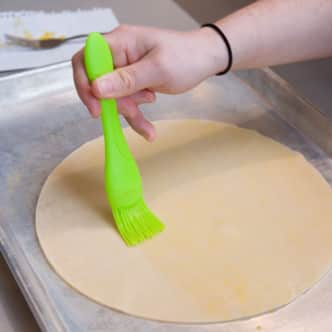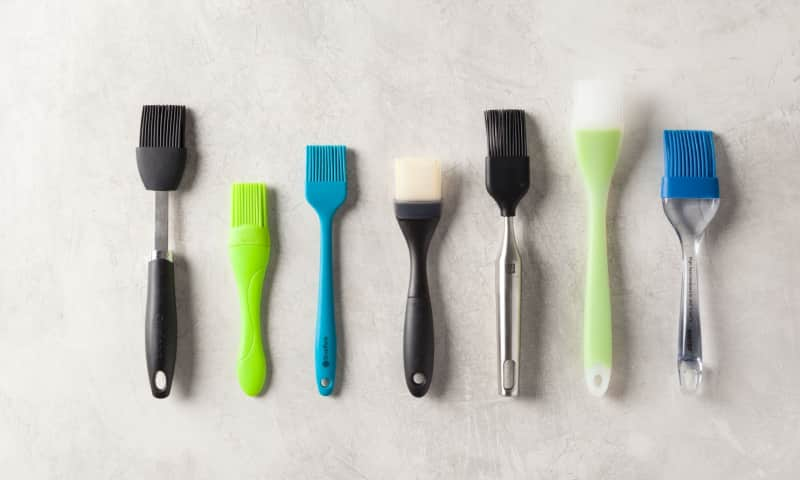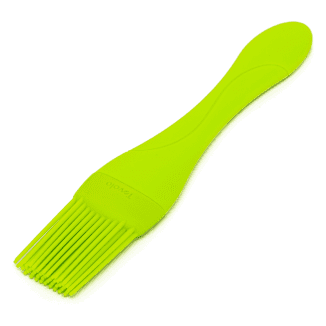In the kitchen, we use brushes for all kinds of tasks: basting, glazing, and spreading melted butter or egg wash, to name just a few. The bristles on these brushes come in two materials—natural fiber (typically boar’s hair) and silicone—and we like each type for different reasons. Natural-fiber brushes are especially good at picking up liquids and distributing them gently and evenly; we use them for pastry and other tasks where control and a delicate touch are critical. Silicone brushes don’t pick up as much liquid as their natural-fiber counterparts, and they are a little rougher on delicate foods. But they never shed, are heat-resistant to high temperatures, and are much easier to clean. We recommend them for basting meat or poultry with glaze or marinade and for greasing hot pans.
It had been a while since we last tested silicone brushes, and we wanted to know if our favorite, the OXO Good Grips Silicone Pastry Brush ($7.99), would hold up against newer competitors. So we bought seven models priced from $4.98 to $21.95, including our old winner. Each brush was dishwasher-safe, heat-safe to at least 400 degrees, and had a head width of 1.25 to 1.6 inches—the most commonly available size. We used the brushes for a few typical tasks, including applying ketchupy glaze to meatloaf and melted butter to a hot skillet, as you might do to prep the surface for pancakes. We also used the brushes to apply egg wash to pie dough, because while natural-fiber brushes generally do a better job with this task, many home cooks might have only a silicone brush or prefer to use one for its easier cleanup with the raw egg.


Brush Design Affects Performance
We were surprised to find that despite differences in the length, thickness, and number of bristles, almost all the models performed similarly. We weighed the amount of liquid that each brush picked up on each pass and found relatively little variation, except for one model. This brush took up about two-thirds the liquid that the other brushes did and therefore required almost twice as many passes as the other brushes to glaze the entire surface of the meatloaf and a few extra passes to cover the pie dough and the hot skillet. Why? This brush had the narrowest head in the lineup, which measured 1.25 inches wide. It was just too small to provide enough coverage; we preferred brushes with slightly wider heads of at least 1.5 inches.

The flexibility of the bristles also mattered. Those that were too floppy were harder to control and direct, dripping and flicking liquid a little bit more than we liked. Bristles that were too rigid were rougher and less agile, poking at the soft meatloaf and occasionally threatening to gouge holes in it. We found the happy medium in moderately flexible bristles, which gave us the precision we wanted without sacrificing sensitivity.
...anything longer [than 5 inches] made it feel as if we were basting with the proverbial 10-foot pole.
What Made Brushes More Comfortable To Use
A few brushes were too heavy, proving less comfortable to wield for extended sessions; we preferred those that were relatively light, under 2 ounces. We liked handles about 5 inches long—anything shorter felt toy-like for large hands, and anything longer made it feel as if we were basting with the proverbial 10-foot pole. We also liked moderately thick handles, about 2.75 inches in circumference, as thinner handles cramped our hands and thicker ones were harder for testers with smaller hands to hold and control for longer periods. Finally, we preferred handles made from silicone or rubbery plastic, as these rougher textures helped us get a grip on the tools even when they got a little slick from butter or glaze—smooth plastic or metal was harder to hold.
A Word Of Caution About Durability
In general, silicone brushes are vastly more durable than natural-fiber ones, but they’re not impervious to damage or signs of use. After we left the brushes in a hot skillet—as any cook might do—the bristles on all the models were unscathed. But several of the handles melted slightly where they’d been in contact with the skillet edge. And when we submerged the brushes in a slurry of garlic and chipotle in adobo sauce, brushes with lighter-colored or clear bristles retained mild stains even after several washes; all the brushes still smelled faintly of chipotle after six dishwasher cycles. Happily, these issues were just aesthetic and didn’t affect the brushes’ functionality; even the most significantly stained brushes didn’t transfer color, flavor, or smells to food afterward.

Our Favorite Silicone Brush: Oxo Good Grips Silicone Pastry Brush
In the end, our former favorite came out on top again. The OXO Good Grips Silicone Pastry Brush ($7.99) performed well; its moderately flexible bristles apply liquids in a controlled but gentle fashion. The brush is lightweight and has a grippy, nicely sized handle, so it’s very comfortable to use. We just wish that the handle were a little more durable—it melted slightly on contact with the hot skillet—and that the bristles were a bit darker, as they turned yellow and stayed that way after sitting in the adobo sauce, though both issues were purely aesthetic.
- 1.5-inch-wide head
- Moderately flexible bristles
- Relatively light weight
- Grippy handle of medium length and thickness
- Brush egg wash onto pie dough
- Brush glaze onto meatloaf
- Brush melted butter onto hot cast-iron skillet
- Leave brushes in hot skillet; examine for damage
- Leave brushes in slurry of garlic and chipotle in adobo sauce; wash 6 times, examining for odors and stains
- Have users of different hand sizes, dominant hands, and levels of pastry experience test-drive


 Buy at Walmart
Buy at Walmart





